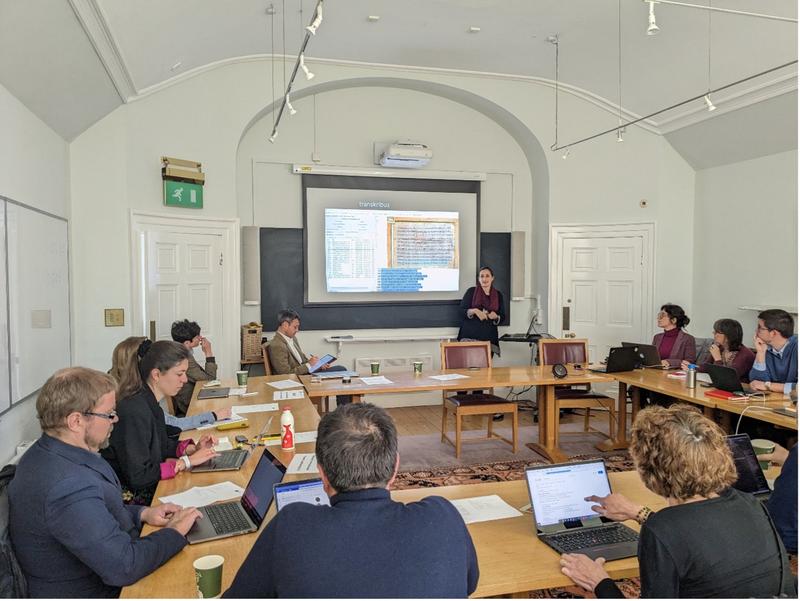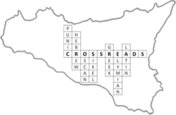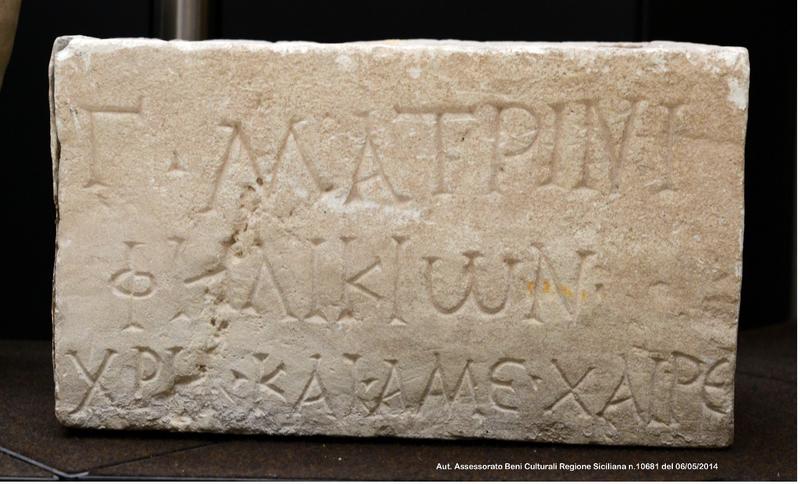Why abbreviate?
A workshop report: Abbreviations in Ancient and Medieval writing systems
A key aim of the Crossreads project is to analyse Sicilian inscriptions for evidence of linguistic interference – in other words, evidence in the inscriptions for the interactions between different languages at the hands of different language users. This is not a particularly new field of study, but the I.Sicily data gives us a new opportunity to study a rich body of evidence from a region that was strongly bilingual, if not multilingual, for much of antiquity.
In beginning to examine the material for examples of such interference, we have been struck by inscriptions such as this one, from ancient Syracuse.
This is a ‘cinerary urn’, a stone chest intended to hold the ashes of the deceased – one Gaius Matrinius Felicio. The dead man has a Roman name, but the text is written in Greek (a perfectly common occurrence in the imperial period; Φηλικίων is the Greek form of a Latin cognomen Felicio). The rest of the inscription, ‘worthy and blameless, farewell!’ follows a formula that is typical of the region of Syracuse, but in fact not found outside south-eastern Sicily. What is particularly interesting here, however, is that the text uses interpuncts (dots) between every word and that the typical Syracusan Greek phrase, χρηστὲ · καὶ · ἄμεμπτε, ‘worthy and blameless’ has both the adjectives abbreviated to their first three letters. Both of these features are much more typical of Latin epigraphy. Was Matrinius a Latin speaker wanting to use the typical local Greek funerary formula, to show off his culture? Or a Greek speaker with Roman citizenship wanting to show that he knew how to do a proper Roman funerary inscription, even if still written in Greek?
In either case, what this and other similar examples suggest is that the practice of abbreviation is one of many potential choices that language users engage with, and this got us thinking. Abbreviations are a significant part of many of the world’s writing systems. Yet despite their ubiquity especially in Latin inscriptions, in Ancient Greek and Latin they turn out to be understudied in their own right: research has instead tended to focus firstly on simply being able to resolve the abbreviations, and secondly on simple diagnostic applications, such as dating particular inscriptions (e.g. using the presence of the abbreviation ‘D(is) M(anibus)’, common at the head of funerary inscriptions, as a criterion for dating). When we started to look it became clear that, at least in epigraphic studies, there was little serious consideration of the practice, with the saving of time and space being almost always the only explanation on offer.

Fig.2: Isabelle Marthot-Santaniello speaking on abbreviations in papyri
In view of this lack of research Jonathan Prag (PI, Crossreads Project) and Robert Crellin organised a workshop (18 – 19 April, Merton College, Oxford) bringing together scholars from adjacent fields to establish the current state of the art in terms of understanding in each field, and (perhaps) outline new ways of approaching the issue in the future.
Sessions were held on graphematics, epigraphy, medieval manuscripts, numismatics and NLP in papyrology and epigraphy. By way of introduction, Jonathan Prag and Robert Crellin assisted by Simona Stoyanova gave an overview of the phenomenon of abbreviation in Greek and Roman Sicily. Yannis Haralambous (IMT Atlantique) then outlined the important graphematic issues relating to abbreviations. Talks on epigraphy were given by Marietta Horster (Mainz, Greek and Latin), John Bodel (Brown, Latin), Aitor Blanco Pérez (Navarra, abbreviations in Greek inscriptions from the Greek East) while Jerome Mairat (Oxford) and Suzanne Frey-Kupper (Warwick) spoke on abbreviations on coins in both the Greek and Roman worlds.
Abbreviatory practices in medieval manuscripts were addressed in four talks: Teresa Webber (Cambridge) spoke on the situation in medieval Latin manuscripts; Alpo Honkapohja (Oslo) on some issues in the typology of abbreviations in medieval sources; Colleen Curran (TCD) on early medieval insular abbreviations, and Sebastian Dows-Miller (Oxford) on abbreviations in medieval French manuscripts.
Isabelle Marthot-Santaniello (Basel) and Audric Wannaz (Basel) spoke on applying Natural Language Processing techniques to the analysis of abbreviations in papyri, while Nina Sietis (Cassino and Southern Latium) spoke on palaeographic analysis of abbreviations on papyri. Finally, Thea Sommerschield (Venice) discussed the treatment of abbreviations in the creation of machine-learning models for the geographical attribution of Latin inscriptions (and in future for text restoration tasks).
Discussion was wide-ranging, yet some common themes and questions were readily discerned:
- Motivations: We observed that the use of abbreviation is very frequently attributed to the desire to save space and time on the part of the writer. However, in many cases (e.g. monumental inscriptions) this seemed an unlikely explanation, given the great expense involved in creating the monument in the first place. Our example of the Syracusan funerary inscription above fits in here too – other Greek funerary inscriptions, with no more or less space available, don’t bother to abbreviate the phrase, so why did Matrinius? In these cases, at least, other factors, such as language or culture-specific choices, or greater accessibility to readers were suggested; but mediaeval manuscript studies also highlighted the variability of practice between individual scribes.
- Materials: The relationship between the physical nature of the objects and tools used in writing and abbreviation came up in a range of contexts, as did the spatial context on the page/surface (e.g., line-ends).
- Readership: Do abbreviations make texts harder or easier to read? Abbreviation might be assumed to make reading harder; however, for illiterate audiences, abbreviation might in fact make reading (part of) what is written easier, insofar as the abbreviation is treated can be treated as an arbitrary geometical shape with a readily identified meaning in context.
- Terminology: The use of terms was observed to differ between fields. For example, the term ‘ligature’ is used in different ways in epigraphy and papyrology.
- Typology: What counts as an abbreviation differs across fields. In particular, the place of monograms appeared to be intermediate between abbreviation and other forms of writing.
- Analytical methods: the increasing potential for the application of quantitative approaches to analysing abbreviations was discussed and exemplified several times, as were the associated challenges of systematic encoding.
A publication is planned summarising the status quo in the fields covered, and outlining (the many) avenues for future work, not least in bringing more of the world’s writing systems into consideration. The organisers would like to take this opportunity to thank all those who took part for a profoundly interesting workshop.
G.V.A.
(Gratius vobis amibus)
The blog of the CROSSREADS project, based at the CSAD in the Faculty of Classics, University of Oxford, between 2020-2025. We will be adding regular updates on our research and news of our project publications.
CROSSREADS: text, materiality and multiculturalism at the crossroads of the ancient Mediterranean has received funding from the European Research Council (ERC) under the European Union's Horizon 2020 research and innovation programme (Grant agreement No. 885040).




